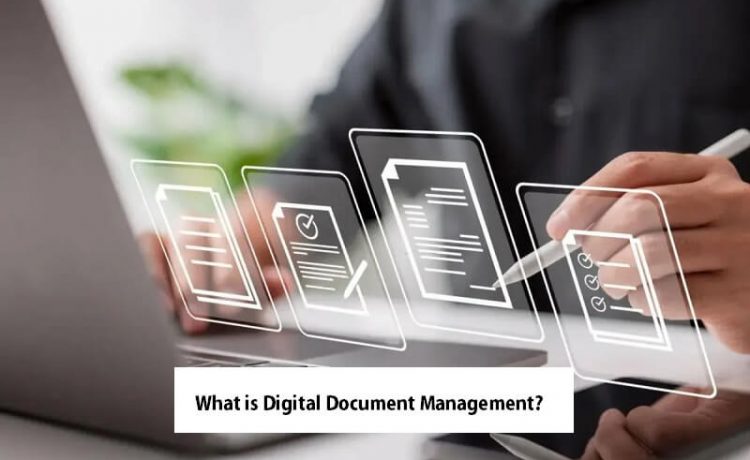What is Digital Document Management?

Digital document management is vital for organizations aiming to streamline operations, enhance collaboration, bolster security, and ensure seamless access to critical information.
This manual provides a comprehensive overview of digital document management, covering its benefits, best practices, essential tools, implementation strategies, and return on investment (ROI).
Digital document management: what is it?
Digital document management refers to the organized handling, storage, and retrieval of documents in electronic formats. By leveraging specialized software, it replaces traditional paper-based systems with a more efficient and secure solution. Modern solutions often include features like mobile fax, allowing users to send and accept faxes directly from their smartphones, further streamlining workflows, and reducing reliance on outdated hardware. Beyond improving efficiency, digital document management helps organizations comply with industry regulations and legal standards, ensuring accountability and adherence to requirements.
Benefits of digital document management
- Increased efficiency. Save time and reduce errors by automating manual processes.
- Enhanced security. Protect sensitive data with advanced features like encryption, redaction, role-based access controls, and time-stamped audit trails.
- Cost reduction. Lower operational expenses by eliminating the need for physical storage and paper-based systems.
- Improved accessibility. This feature enables quick and seamless access to documents from any location, supporting remote, on-site, and hybrid work environments.
- Simplified compliance. Streamline adherence to regulatory standards, such as GDPR, by organizing and tracking documents efficiently.
- Better decision-making. Leverage built-in reporting and business intelligence tools in systems like Document Manager to make informed, data-driven decisions.
Key features of a digital document management system (DMS)
- Document capture and indexing. Convert paper documents into digital formats and tag them with metadata for easy search and retrieval.
- Advanced search functionality. Quickly locate files using robust search tools that save time and boost productivity.
- Version control. Keep documents updated by tracking changes, managing version history, and ensuring centralized access to the latest versions.
- Role-based access controls. Restrict document access to authorized users based on roles and permissions, safeguarding sensitive information.
- Comprehensive audit trails. Track all document-related actions to ensure accountability and compliance, simplifying internal quality assurance and external audits.
Organizations can transform their operations by adopting digital document management and using the Fax App, ensuring greater efficiency, security, and adaptability in today’s fast-paced digital environment.
Best practices for digital document management
- Centralized storage. Store all documents in a secure, centralized location to ensure easy access and organization.
- Automate workflows. Streamline processes by implementing automated document routing, approvals, sharing, and archiving workflows.
- Regular backups. Conduct regular backups to safeguard against data loss and maintain business continuity.
- Enhance data security. Protect sensitive information with robust security measures like encryption and multi-factor authentication (MFA).
- Ensure compliance. Keep up-to-date with industry regulations like GDPR or HIPAA, and ensure your document management system (DMS) is compliant. Embed compliance best practices into workflows to reduce errors and activate automated data retention and purging to align with legal timelines.
- Employee training. Regularly train employees to utilize the DMS and minimize errors fully. Many systems offer advanced features that users overlook without thorough orientation and training.
Choosing the right digital document management system
When selecting a DMS, consider these key factors:
- Scalability. Choose a system that can scale with your organization’s growth.
- Ease of use. Opt for a platform with an intuitive interface to encourage user adoption.
- Integration capabilities. Ensure the system integrates seamlessly with your existing tools, such as CRM, ERP, or financial software.
- Customizability. Select a DMS with customizable features, including dashboards that fit users’ specific workflows and frequently performed tasks.
- Support and training. Verify that the vendor offers comprehensive support and training resources.
- Product roadmap. Choose a provider with a clear roadmap for future updates to address evolving regulations and market trends.
- Proven security. Ask about the vendor’s accreditations and frequency of security testing, such as penetration testing, to ensure the DMS meets high-security standards.
Steps for implementing a digital document management system
- Assess your needs. Identify your organization’s document management requirements, including security, document types, and workflows.
- Select the right system. Choose a DMS that aligns with your assessed needs and future goals.
- Migrate documents. Digitize paper records and transfer existing digital files into the new system for a unified repository.
- Train your team. Provide thorough training to ensure employees can effectively use the DMS’s features. Include compliance education and how to address potential privacy issues.
- Monitor and optimize. Continuously evaluate the system’s performance and adapt where needed. Use vendor-provided tools to refine workflows without requiring technical expertise.
Overcoming common challenges
- Resistance to change. To make adoption smoother, get employees involved early in the selection process and offer solid training.
- Data migration. Plan your migrations carefully to keep data intact and avoid any loss. Many vendors handle complex migrations, especially after mergers or acquisitions.
- Compliance risks. Run regular audits to ensure your system complies with all relevant regulations and standards.
Future trends in digital document management
- AI and Machine learning. AI is set to transform how we index, search, and analyze documents. Using AI during data capture can boost accuracy, while machine learning helps systems evolve and get smarter over time.
- Mobile accessibility. With remote work on the rise, mobile-friendly DMS platforms are becoming essential, letting users manage documents anytime, anywhere.
Useful external resources
- AIIM – The Association for Intelligent Information Management.
- GDPR compliance checklist – A handy tool to stay on top of data protection rules.
- NIST – National Institute of Standards and Technology: Data Security Guidelines.
- Cloud security alliance – Tips and best practices for securing your cloud environment.
By following this guide, organizations can easily implement and manage a digital document management system. This enhances efficiency, boosts security, ensures compliance, and sets the stage for long-term growth and innovation.
Interesting Related Article: Enhancing Innovation with AI-Driven Innovation Management Software.
